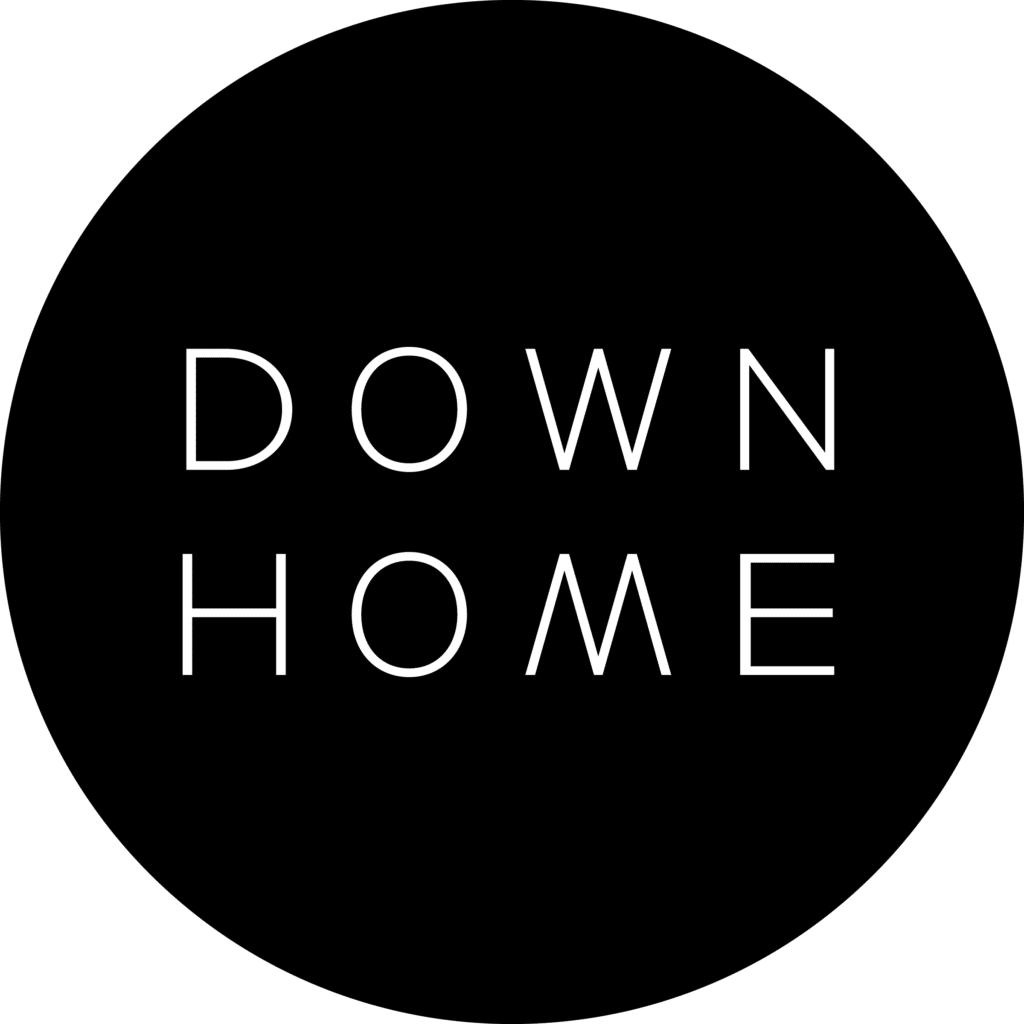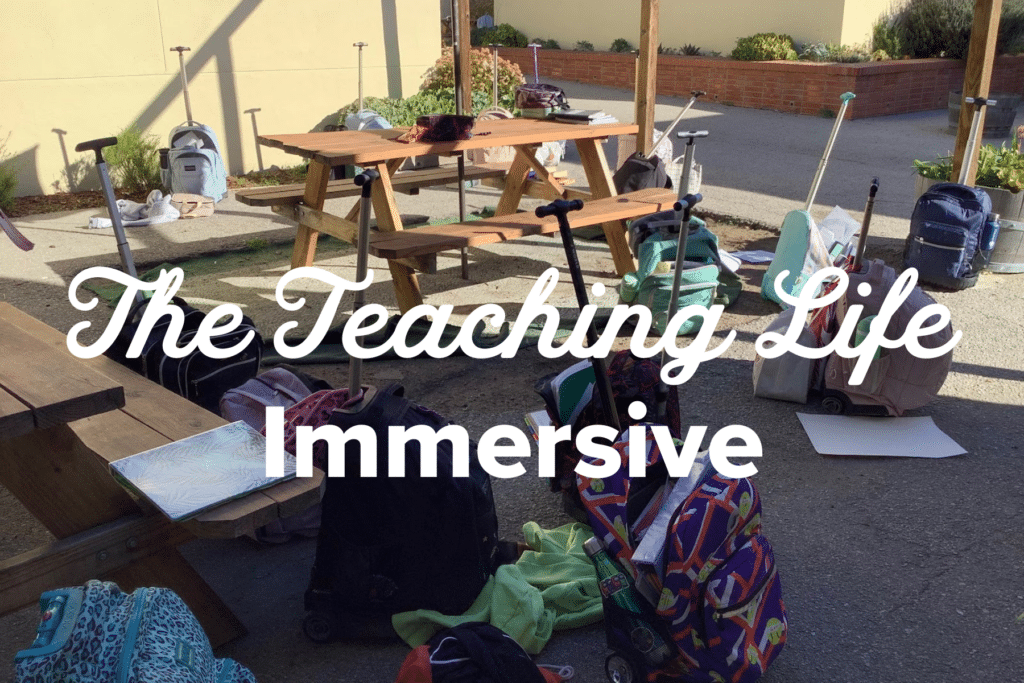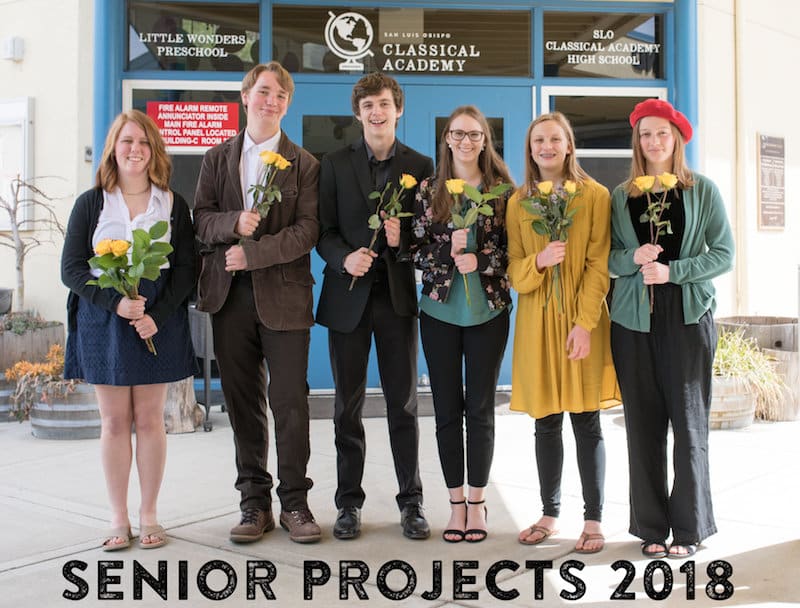
{photo by Carolyn Eicher}
Every year our SLOCA High School Seniors take a semester to work on individual research projects, which cover a variety of topics and showcase the interests and skills of each student. Each project starts with a question. But beyond simply compiling the relevant facts and figures to answer that question, the seniors forge a path of deeper inquiry into their chosen topic, pondering the very origin and nature of the question itself as they research. Finally, they write a paper and publicly present their findings, thoughts, and conclusions.
The Senior Project is considered the capstone of a student's classical education, combining the Grammar stage (learning the facts), the Logic stage (thinking and asking questions), and the Rhetoric stage (expressing their thoughts winsomely). They are incredibly enjoyable to watch – very much like SLOCA’s version of Ted Talks!
This year our six seniors did a phenomenal job presenting their projects to an audience of Upper Middle School and High School students, teachers, parents, and other family and friends. While we wish we could recreate all six projects here on the blog, it would take up quite a bit of space and time. What we can do is present to you the main ideas of each project. So here is Part 1 of our Senior Project series, which will highlight two of our students’ projects:
 Cormic Calloway: The Philosophy of Walking
Cormic Calloway: The Philosophy of Walking
Question: What were the benefits of walking for 19th and 20th century writers, and how can those benefits be transferred for modern people?
“I think that I cannot preserve my health and spirits, unless I spend four hours a day at least – and it is commonly more than that – sauntering through the woods and over the hills and fields, absolutely free from all worldly engagements.”
~ Henry David Thoreau
For many, walking is simply a means of transportation. But for others, like Thoreau, walking is much more than that. He became a better person and a better thinker by walking. Walking can freshen your mind and focus your train of thought.
My goal was to define three different categories of walkers, each with two different sub-categories, so that when you walk you’ll know how you should walk, where you should walk, and why you should walk:
1. Thinking Walkers vs. Non-Thinking Walkers (How you walk)
Thinking Walkers: One who walks to organize their thoughts and come to conclusions (or not) about their own questions. Thinking Walkers let their thoughts flow while they walk because movement heightens the ability to think.
Non-Thinking Walkers: The non-thinking walker is “A person who walks to silence their thoughts so that they can meditate. When they set out, the non-thinking walker wants their mind to slow down so that they may connect to the world.”
2. Nature Walkers vs. City Walkers (Where you walk)
Nature Walkers: A nature walker is a thinking/non-thinking walker who enjoys strolls alone in a natural environment. Nature walkers gravitate towards long distance walking.
City Walkers: A city walker is a thinking/non-thinking walker who strolls in a busier more human-filled place than the natural world (such as a town or city), yet still walks for the same basic reasons as the nature walker. City walkers still value calmness and connection to their environment as the nature walker does, but they desire a stronger connection to the liveliness of a town or a city.
3. Contrary “No” Walkers vs. Affirmative “Yes” Walkers (Why you walk)
No Walkers: A no walker is someone who understands the unjust aspects of a faulty world but simply accepts them as fact. Because the no walker believes the world has unhealthy parts, they walk to disconnect themselves from the world’s imperfections and connect to the perfections of it.
Yes Walkers: A yes walker agrees with the state of the world. Because the yes walker believes the world is organically pure, they stroll to connect themselves to it. Yes walkers do believe in imperfections, but unlike the no walker, they do not believe the world is the cause of them. They think that imperfections exist because people are disconnected from the just and perfect world.
Categories
I took these six categories and separated them into six different types, like the Myers-Briggs test, to represent the mindset and setting in which people walk:
T for Thinking Walker
O for Non-Thinking Walker
R for Nature Walker
C for City Walker
N for No Walker
Y for Yes Walker
I am a T-R-Y walker, so I walk with a thinking mindset, in nature, alone, generally agreeing with the state of the world.
I then translated the different types into a graph, and approximately placed a few characters and historical figures on the graph to show how it works:
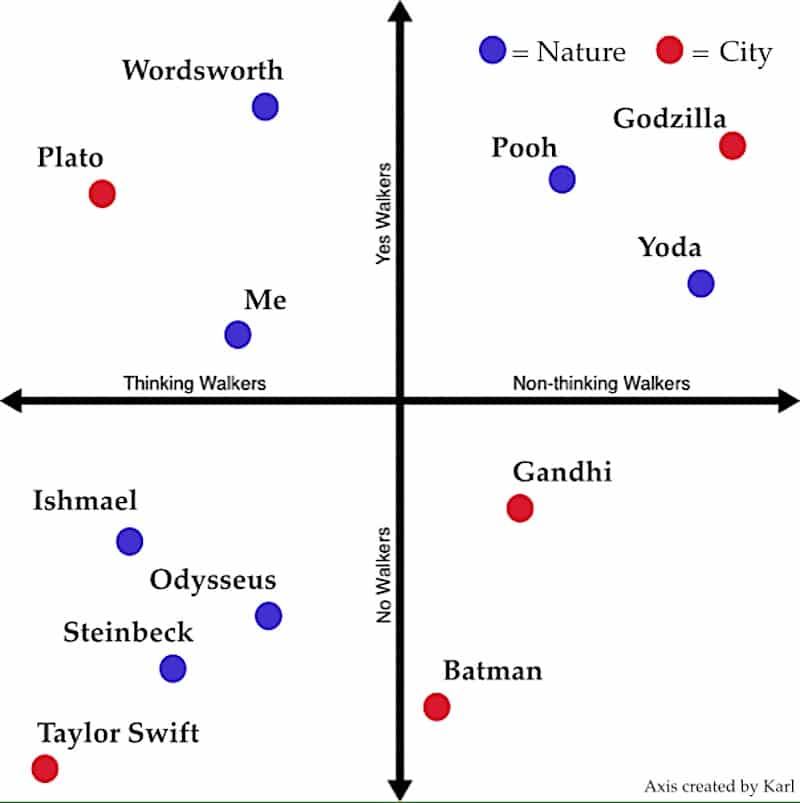
Which categories correspond to your own way of walking and thinking? Find where you fall on this graph as you think about How, Where, and Why you walk. Walking is a vital skill that has helped thinkers for centuries, and I hope these categorizations aid you in your thinking.
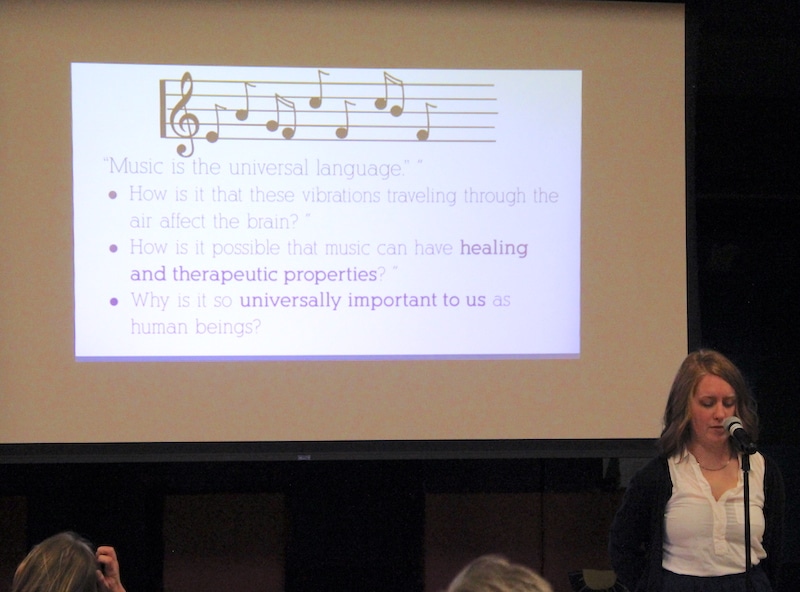 Kate Bischoff: Music and Mystery (Music Therapy)
Kate Bischoff: Music and Mystery (Music Therapy)
Questions: People say “Music is the universal language.”
- How is it that these vibrations traveling through the air affect the brain?
- How is it possible that music can have healing and therapeutic properties?
- Why is it so universally important to us as human beings?
Music affects the brain neurochemically by increasing the hormones Dopamine (known as the “Feel-good” hormone) and Oxytocin (known as the “Love” hormone), as well as Immunoglobulin A (IGA), which is an antibody used for fighting infections.
In a study done at Stanford, different non-musical participants had their brains scanned while listening to classical music and experienced almost identical results across the board. Music is shown to be globally processed throughout the brain.
The hippocampus and auditory cortex are both located in the temporal lobe. Music is treated differently than other sounds coming into the brain, and is one of the only forms of sound that activates the hippocampus as well as the auditory cortex, which is why it’s so much easier to remember things in song. Patients with dementia or Alzheimer’s often don’t remember their children’s names but can remember songs from their 20s. Music also engages the motor cortex (which explains foot tapping and dancing to catchy songs).
In “The World In Six Songs,” author Daniel Levitin explains the hypothesis that music has always been a characteristic of a strong community (ever since David in the Psalms) because we have adapted to release oxytocin and enjoy partaking in music with one another. However, listening to and playing music is one of the only things we’ve adapted to enjoy that has no direct correlation to our survival as a species, unlike actions such as eating food, drinking water, sleeping, and having sex. There is no scientific explanation for why music releases these neurochemicals and activates all these regions of our brains.
I believe that the only way to explain this phenomenon is that we were created in the image of a God who is a perfectly musical being, whose ways will always be far outside of our understanding. This, of course, is not a scientific argument by any means. But I don’t think that we need to be constrained only to scientific explanations, and our experience with music transcends our ability to technically understand it.
I think it makes complete sense that something so universally applied and enjoyed can also be applied in a therapeutic setting. Music Therapy is an established and growing health profession, in which music is used in a therapeutic setting to achieve non-musical communicative, physical, emotional, or cognitive goals with patients. This can include creating, singing to, moving to, or listening to music.
Music therapy can…
- Aid in the recovery of basic skills after brain injury – Gabby Giffords is a congresswoman who re-learned how to talk through singing in 10 months, after a bullet wound to the left hemisphere of her brain. Singing rather than talking can create a new neuropathway in the right hemisphere.
- Reduce asthma episodes – In an Australian study, singing and playing wind instruments (a didgeridoo) was shows to relax and strengthen respiratory muscles.
- Reduce pain – Many patients become dependent on pain medications and develop addictions to them, but Music Therapy has been seen to aid in pain management. Music Therapy offers a nonpharmacologic and safe alternative to medications in some cases.
- Improve speech in people with autism – Speech Therapy and Music Therapy used in conjunction have been found to strengthen both the left and right sides of the brain and provide an outlet for creative expression when clients are unable to verbally express themselves as easily.
- Improve general motor strength and control in children with special needs – By engaging the motor cortex, Music Therapy can support and encourage movement through dance.
The list is more expansive and still growing. Here’s a video I made to accompany my project:


